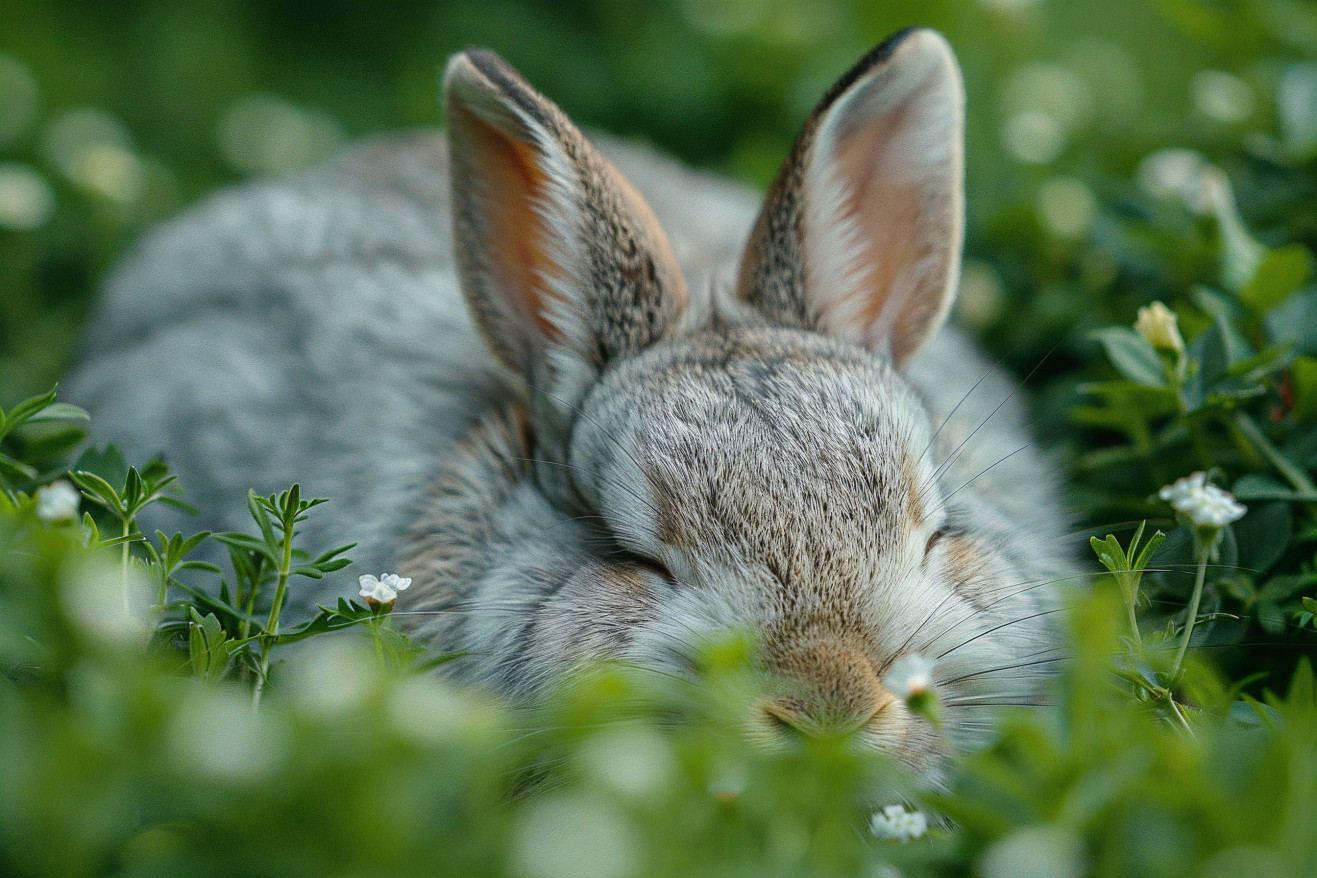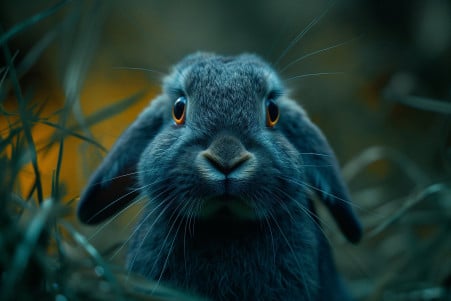Why Do Rabbits Sleep With Their Eyes Open? Rabbit Sleep Secrets
22 March 2024 • Updated 21 March 2024

If you’ve ever owned a rabbit, you’ve probably noticed that their eyes don’t fully close when they sleep. This strange phenomenon has led many rabbit owners to wonder why their pets sleep with their eyes open and what this means for their sleep quality and overall behavior. Rabbits do sleep with their eyes open, and they use a process called "unihemispheric slow-wave sleep" to do so, which allows one half of their brain to stay awake and alert while the other half sleeps.
In this article, we’ll take a deep dive into the science behind rabbits’ ability to sleep with their eyes open, drawing on research from the fields of animal behavior, neuroscience, and evolutionary biology.
By doing so, we’ll uncover the biological processes that make this way of sleeping possible and learn how rabbits have adapted to ensure they get the rest they need while staying safe from potential predators. In the process, we’ll gain a greater understanding of the incredible survival skills that rabbits have developed.
Do rabbits sleep with their eyes open?
Evolutionary Traits That Help Rabbits Survive
Rabbits are prey animals, and as such, they have developed a number of physiological and behavioral traits to help them avoid predators. For example, their eyes are positioned on the sides of their heads, which allows them to see in almost every direction. In fact, the only area they can't see is directly in front of them.
In addition, rabbits have a lot of rods in their eyes, which makes them more sensitive to light and allows them to see better in the dark than many other mammals. This is important because rabbits are most active at dawn and dusk, and this extra sensitivity to light helps them avoid predators during these times. Another way that rabbits' eyes help them avoid predators is that they have a third eyelid, or a nictitating membrane, that allows them to sleep with their eyes open.
All of these traits show how rabbits' behavior and physiology have been shaped by their evolution as prey animals. By being light sleepers that can see in almost every direction and having eyes that are especially sensitive to light when they are most active, rabbits have developed a number of traits that help them avoid predators. In fact, the fact that they can sleep with their eyes open is a perfect example of how rabbits have evolved to survive despite the constant threat of predators.
Anatomy and Physiology of Rabbit Eyes
Rabbits have a number of special eye features that have evolved to meet the needs of their life as a prey species that primarily eats plants. For example, their eyes are located on the sides of their heads, which gives them nearly 360-degree vision with only a small blind spot in front. Research from the Office for Science and Society at McGill University explains that this means rabbits can see potential threats from almost every direction.
Rabbits also have a third eyelid, called a nictitating membrane, that's transparent and helps keep their eyes moist when they're sleeping with their eyes open. The PDSA explains that this is important because it means rabbits can stay alert to predators even when they're taking a nap.
In addition, the blood vessels in rabbits' retinas are arranged differently than in other mammals, with a horizontal pattern instead of a radial one. A study in the Journal of Comparative Neurology also found that rabbits have a large blood vessel plexus behind their eye globes, which is important to know when performing eye surgery on rabbits.
These special features of rabbit eyes have evolved to help rabbits survive in the wild. By knowing about them, we can see how rabbits' eyes, vision, and even sleep patterns are all tied to their need to get enough rest while staying safe from predators.
How Do Rabbits Sleep in the Wild?
Rabbits are crepuscular, which means they are most active during the early morning and late evening hours when their primary predators, such as owls and hawks, are less active. This crepuscular activity pattern enables them to forage and move around during the times of day when their visual predators are least likely to spot them.
To ensure they can rest and sleep without being attacked, rabbits dig extensive, intricate underground burrows called warrens that they use for shelter and protection. These warrens can be as deep as 9.84 feet below the surface and have multiple entrances that rabbits can use to quickly escape from predators. As Verlo explains, rabbits will take short naps in their warrens throughout the day and night, rather than sleeping for one long period.
The way rabbits sleep in the wild is also dependent on the position of their bodies and other factors, such as the temperature and the need to stay on the lookout for predators. Bunnylady notes, rabbits will stretch out or flop over to stay cool in warm weather, but they will curl up in a more compact position, known as the "loafing" position, to conserve heat when it's cold. No matter how they position themselves, rabbits sleep lightly so they can wake up and escape at the first sign of danger.
Rabbit sleep patterns in the wild show how rabbits' natural behaviors and survival instincts are shaped by their need to avoid predators. Their crepuscular activity, their use of warrens for shelter, and their ability to sleep lightly so they can escape predators all demonstrate the many ways rabbits have adapted to their role as prey animals.
How Rabbit Sleep Compares to Other Mammals
Sleep in mammals is highly diverse and has been shaped by a number of factors, including diet, body mass, and brain evolution. As herbivores, rabbits are an example of a species with relatively low total sleep time compared to carnivores and omnivores. Wikipedia notes that rabbits sleep an average of 8.4 hours per day, which is less than other small mammals like mice and cats, which sleep over 12 hours per day. This is consistent with the negative correlation between body mass and sleep time observed in herbivores, as noted in Campbell and Tobler’s review.
Rabbits, like other small mammals, are also polyphasic sleepers, meaning they have multiple sleep and wake episodes throughout the day and night. However, the amount and quality of REM sleep in rabbits is different from other mammals, likely due to their unique evolutionary history as prey animals. One study in the Journal of Comparative Neurology found that while rabbits respond to paradoxical sleep deprivation in a manner similar to other mammals, their rebound and phasic activity during REM sleep is more constrained.
In general, looking at the commonalities and differences in sleep across mammalian species helps put the unique sleep of rabbits into context. Their status as prey animals has clearly led to some unique adaptations in their sleep compared to other mammals, which makes their sleep even more fascinating and worthy of study.
Conclusion: What Rabbit Sleeping Habits Tell Us
Rabbits' sleeping habits, including sleeping with their eyes open, are a result of their long history as prey animals. The unique anatomy and physiology of their eyes enable them to get the rest they need while remaining constantly alert for predators.
Studying rabbit sleep in the wild shows how their sleeping habits are influenced by their environment and the need to avoid predators. Comparing rabbit sleep to other mammals shows how sleep patterns have evolved in different species.
Understanding the special adaptations that enable rabbits to sleep with their eyes open can help us better understand these animals and their place in the animal kingdom.


